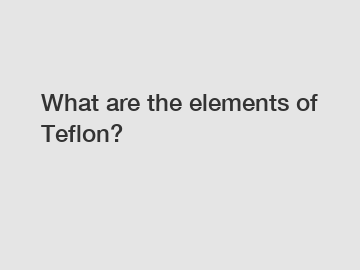What are the elements of Teflon?
What are the Elements of Teflon?
Since its discovery in the late 1930s, Teflon has become an integral part of our daily lives. From non-stick cookware to industrial applications, Teflon's unique properties have made it one of the most versatile materials in the world. But, have you ever wondered what elements make up this remarkable substance? In this article, we will delve into the composition of Teflon and explore its various elements.
#Polytetrafluoroethylene (PTFE): The Backbone of Teflon.

As the main component of Teflon, polytetrafluoroethylene (PTFE) is a synthetic fluoropolymer of tetrafluoroethylene. It is remarkable for its numerous desirable characteristics, making it widely used in many applications. PTFE is a combination of carbon and fluorine atoms, with carbon atoms forming the backbone of the polymer chain, while fluorine atoms surround them. This unique molecular structure gives Teflon its exceptional non-stick properties, low friction coefficient, high thermal stability, and excellent chemical resistance.
#Carbon and Fluorine: Building Blocks of PTFE.
Two key elements found in PTFE are carbon and fluorine. Carbon is a vital component of organic compounds, forming strong covalent bonds with other carbon atoms or other elements. In PTFE's molecular structure, carbon atoms create a strong backbone by sharing electrons with one another. This carbon-carbon chain provides stability and resilience to the material.
On the other hand, fluorine atoms are responsible for Teflon's well-known non-stick properties. Fluorine is the most electronegative element, meaning it strongly attracts and holds onto shared electrons. Since the electrons in the carbon-fluorine bond are pulled closer to the fluorine atom, this creates a shielding effect. Consequently, the fluorine atoms create a protective layer around the carbon backbone, preventing other substances from sticking to the surface.
#Perfluorooctanoic Acid (PFOA): A Concerning Element.
It is important to note that Teflon production historically involved the use of perfluorooctanoic acid (PFOA). PFOA was used as a processing aid in the manufacturing of PTFE. However, due to environmental and health concerns, major manufacturers phased out PFOA usage. Since 2013, Teflon products have been manufactured without the use of PFOA, resulting in safer and more environmentally friendly alternatives.
Nevertheless, it is essential to handle and dispose of Teflon products responsibly, as any misuse can still lead to the release of harmful substances. As a responsible user, always follow manufacturers' guidelines and recycle Teflon products properly.
#Conclusion.
In conclusion, Teflon is primarily composed of polytetrafluoroethylene (PTFE) – a remarkable material made up of carbon and fluorine atoms. The carbon backbone provides stability and resilience, while fluorine atoms create a non-stick surface. Furthermore, the phasing out of perfluorooctanoic acid (PFOA) from Teflon production has made Teflon products safer and more environmentally friendly.
Teflon's unique properties have made it an indispensable material in various industrial and domestic applications. Whether used in cooking utensils, electrical wires, or even spacesuits, Teflon's resistance to heat, chemicals, and adhesion has proven to be invaluable.
For more information on Teflon and its elements, feel free to contact us. Our team of experts is always ready to answer any questions you may have or help you explore the world of Teflon further.
Contact us today to discover the endless possibilities of Teflon!
If you are looking for more details, kindly visit ptfe plastic sheet, ptfe tube manufacturer, Expanded PTFE Sheet.


